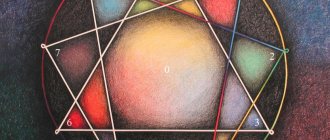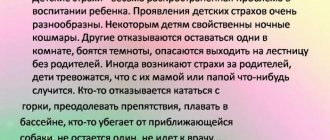- What is the Stroop test
- The Stroop effect as a psychological test
- Stroop test: a little history
- Modified Online Stroop Test
The Stroop test , or the Stroop effect , or the Stroop task , is an interesting phenomenon related to the functioning of our brain. Surely, many have come across this unusual test (after all, it is one of the most famous in experimental psychology and is widely distributed on the World Wide Web), but they knew little about it. We propose to fill this information gap. We also suggest trying yourself and taking the Stroop test online .
What is the Stroop test?
To understand what the Stroop test is, look at the picture
and name the colors in which
is written
.
It's difficult, isn't it? Looking at a word, we - voluntarily or involuntarily - read it, and when we are asked to name the color, the first one that comes to mind is the one we read, and not the actual one at all. Only by concentrating and mentally discarding what is asked first on the tongue do we name what is required
(and not always the first time). This is precisely what the Stroop effect is, and the Stroop test, in turn, is based on this effect.
The fact that the matter is precisely the contradiction between the information read and the information seen
, is quite easy to prove.
Look at the illustration below - there are no recognizable words here, so you are unlikely to have problems naming the colors in which the letters of the alphabet are printed. The same effect would happen if the words were written in a language you don't know (and we'll get to that a little later).
Why is this happening? In fact, scientists do not yet have a clear answer. It has been precisely established that different lobes of the brain are responsible for color recognition and reading, but why the first of the two options (read and actual) is chosen - here the opinions of experts differ. There is a theory related to saving resources,
- seeing a word in a familiar language, we automatically read it, so a certain ready-made answer appears in our heads, and our brain decides: “Why think again then?”
According to another theory (and it was held by Stroop himself): we read a word faster than we can recognize, remember and name the color
.
That is, the reaction between reading and naming is faster than between color recognition and naming. In addition (and this can be considered the third option), algorithm is more familiar
, since in life it is clearly used more often, and the brain simply follows the beaten path.
Changes in terms and conditions
Despite all of the above, the presented effect can be observed only when, under “color” words, people are offered only the names of colors, and in a language familiar to them.
So what will happen if we change the conditions of the experiment and invite its participants to pronounce the colors of other words, i.e. no color names? And this is what will happen - they will complete the task quite easily, without any difficulties.
So, in order to “confuse” a person and cause that same cognitive dissonance, using the superimposition of information, the experimenter must simultaneously evoke two color images in him, the first of which must activate memory through the meaning of the word and update the image of color using the written concept, and the second image is created already directly by the color itself. Those. if for any reason a person ceases to perceive the meaning of what is written, or the word simply does not create a color image in him, “confusion” will not be achieved and, therefore, the Stroop effect will not occur.
The Stroop effect as a psychological test
The Stroop test is actively used in psychology to determine the flexibility of cognitive thinking.
. If a person can quickly switch from reading words to naming colors, then his cognitive thinking is quite flexible. The test measures the time required for normal color naming and for a similar activity using the Stroop effect. In addition, the number of errors is monitored.
If you are interested in other unusual phenomena related to brain function, read our article on synesthesia.
Among other things, the Stroop test will tell you about the ability to concentrate and concentrate at a given moment. High level of stress, the presence of any unresolved problems that can’t get out of your head, obvious drowsiness, etc. interfere with the Stroop test. However, if a person seems to be fine, but the test is still clearly difficult for him due to the inability to concentrate, then perhaps the subject should pay attention to his ability to concentrate.
Also, tasks based on the Stroop test are often included in various self-development and brain training programs
, since it is, in principle, useful for our mind to establish new connections and be able to switch between them (we talk more about this and various training options in the material devoted to neurobics, or gymnastics for the brain).
Interesting fact about the Stroop effect: it has found application in counterintelligence
- it was used to identify spies. Individuals living undercover in another country may have been well aware of their cover story, but their uncontrollable reaction to the Stroop effect would have given them away. A person who was suspected of spying for another state was given a sheet with a list of colors in a language that, according to legend, he should not know. If naming the colors in which words are written caused difficulties, this, in turn, raised questions among the inspection authorities. After all, as we said, the Stroop effect only works if you are able to read the words and they are familiar to you.
Sidorenko G.I., Komissarova S.M., Frolov A.V., Vorobyov A.P. Republican Scientific and Practical Institute, Belarus
In a large arsenal of functional cardiological diagnostic methods, a significant role is played by the so-called stress tests, which make it possible to determine endurance in conditions close to work processes. In modern working conditions, this is often associated with information loads. It seemed appropriate to us to study the possibilities of psycho-emotional testing using the Stroop method, a computerized version of which we developed [1].
This test has been used since 1935 as the “Gold Standard” in the study of attention and cognition [2]. For the period 1980-2003 There have been more than 41,600 publications devoted to this method. Stroop-color word test is based on the presentation of images or cards with two types of inscriptions. One version of the information presented is made so that the words and colors match (congruent information). With another version of the information presented, the words and colors do not match (incongruent information). The Stroop effect is based on a person's ability to read words more quickly and automatically than to distinguish color names. Assessing the speed of information processing and the number of errors made allows us to judge the concentration of attention under conditions of information loads.
In the computer version of the test, the time (t, s), speed (V, bit/s) of the test is determined, as well as the number of errors (n) when performing the congruent (Vav.) and incongruent (V3) version of the information. When simultaneously assessing the level of increase in systolic blood pressure (SBP) during the test, it is possible to calculate the indicator (F), reflecting the “physiological fee” for processing information using the formula: F = ΔSBP / V3, mm Hg/bit/s.
The Stroop effect is that the productivity of information processing is different in neutral and conflict conditions. The Stroop method allows not only to implement psycho-emotional stress testing, but also to quantitatively evaluate the process of information processing. It seemed appropriate to us to determine the level of the body's neurovegetative stress response during psychoemotional testing. For this purpose, we used the determination of heart rate variability (HRV), which was carried out both before and after the Stroop test in 48 patients with neurocirculatory dystonia (NCD) aged from 25 to 48 years (average age 36.1±2.5 years ). At the same time, the temporal, spectral indicators of HRV were determined, proposed by the European and North American Heart Association [3], as well as the voltage index IN = Amo / 2ΔXMo, proposed by R.M. Baevsky et al.[4].
results
The test results are presented in the table: in 24 (50%) subjects, during psychoemotional testing, a state of tension (anxiety phase) of the neurovegetative system was observed, characterized by activation of the sympathetic tone (LF>55%, LF/HF>2.5, IN>150 arb. units) with well-preserved activity of parasympathetic tone (HF>30%) and the indicator of general rhythm variability (SDNN>50%). When assessing the Stroop test in this category of subjects, the speed of processing incongruent information decreased (V3 1.34±0.02 bit/s), the quality of processed information was maintained (n=0), and a high speed of processing congruent information was observed (Vavg. 2.32± 1.12 bit/s), as well as a high physiological cost for information processing (F 5.2±0.04 mm Hg/bit/s).
Table. HRV indicators before and after performing the Stroop test in various phases of psycho-emotional stress (M±m)
| Indicators | Voltage phase | Maladaptive reaction | Exhaustion phase | |||
| original | Stroop test | Original | Stroop test | original | Stroop test | |
| SDNN, ms | 64,3±4,89 | 73,2±6,33* | 48,8±5,22^ | 52,8±4,78 | 35,6±4,23^^ | 31,3±2,78 |
| IN, conventional units | 108,4±8,99 | 196,1±10,9** | 161,5±12,8^ | 399,5±32,9** | 80,2±7,56^^ | 82,8±7,89 |
| LF,% | 54,6±4,56 | 65,9±6,58* | 42,5±4,45^ | 59,8±4,99* | 30,8±3,22^^ | 29,2±1,98 |
| HF,% | 32,2±2,31 | 40,2±2,34* | 27,8±1,89^ | 29,9±1,78 | 28,9±1,02^ | 27,8±1,15 |
| LF/HF | 2,55±0,76 | 2,84±0,89 | 1,56±0,56^ | 2,1±0,98 | 1,07±0,01^ | 1,06±0,01 |
| Vav.,bit/s | – | 2,32±1,12 | – | 2,12±1,02 | – | 1,08±0,01^ |
| V3, bit/s | – | 1,34±0,02 | – | 1,22±0,01 | – | 0,98±0,06^ |
| N | – | 0 | – | 5,2±0,03 | – | 8,8±0,02^ |
| F, mm Hg bit/s | – | 5,2±0,03 | – | 8,2±0,06^ | – | 10,5±0,09^ |
Note: significance of differences between the initial data and the Stroop test: *-p<0.05, **p<0.01; significance of differences between groups: ^ p<0.05, ^^-p<0.01.
In 12 (25%) subjects, a maladaptive reaction to psycho-emotional stress was revealed, characterized by excessive activation of the sympathetic tone (LF>55%, LF/HF>2.5, IN>250 arbitrary units) with a decrease in the activity of the parasympathetic tone (HF<30 %). According to the Stroop test, a decrease in the speed and quality of processing of congruent (Vsr<. 2.12±1.02 bit/s) and incongruent information (V3<1.22±0.01 bit/s, n>3) was revealed with high physiological board (F>5 mmHg bit/s) in the process of information processing. In 12 (25%) subjects, a decrease in indicators of both the sympathetic and parasympathetic components of HRV (LF<30%, HF<20%, LF/HF<1.0, IN<100 arbitrary units) and general rhythm variability ( SDNN <50 ms). At the same time, the speed of processing congruent (Vav.<1.0 bit/s) and incongruent information (V3<1.0 bit/s) sharply decreased and the number of errors increased (n>5). Such changes in the parameters of the neurovegetative system and cognitive function indicate depletion of the body’s regulatory systems.
Below is an example of using this diagnostic approach.
Example. Patient K., 21 years old. Diagnosis: neurocirculatory dystonia. Initial data: SDNN-51.9 ms, LF 41.7%, HF 29.4%, LF/HF 1.45, IN 195.3 conventional units. After the Stroop test, IN increased to 326.0 conventional units, LF to 57%, HF to 35%, LF/HF to 1.63. During the Stroop test, the speed of processing congruent information remained within normal parameters: Vav.2 78 bit/s, V3 1.07 bit/s, the number of errors was 0. These data indicate tension in the body’s regulatory systems (anxiety phase).
Thus, the combination of the Stroop test with the determination of heart rate variability makes it possible to assess not only indicators of attention and cognitive function, but also to judge the phases of the stress reaction of the body’s regulatory systems. This makes it possible to predict the further course of the disease and judge the effectiveness of treatment and rehabilitation. It is possible that the combination of the Stroop test with heart rate variability can be used to assess performance during intense and long-term loads, and when selecting participants to perform important tasks.
Literature
1. Sidorenko G.I., Frolov A.V., Vorobyov A.P. Psycho-emotional tests and the prospects for their use in cardiology. // Cardiology.2005. vol.45.№6, p.59. 2. Macleod CM The Stroop task: the “gold standard” of attention measures // J.Exper.Psych.General.1992.V.121.P.12 3. Heart rate variability. Standards of Measurement. Physiological interpretation and clinical use.Task of The European Society of Cardiology and North American Society of Pacing and Electrophysiology //European heart Journal.1996. V.17. P.354. 4. Baevsky R.M., Kirillov O.I., Kletskin S.Z. Mathematical analysis of changes in heart rate under stress. M.: Nauka.1968. 220 pp.
Stroop test: a little history
American psychologist John Ridley Stroop published a paper about the effect named after him in 1935. Also, similar studies were described in a German journal 6 years earlier, and the first similar developments were known since the 19th century. Stroop conducted the following experiment
. He gave subjects three lists: in the first, the names of the colors were printed in black ink; in the second, the color of the word and its meaning did not match (as in our example); in the third there were simply groups of squares of different colors.
First, participants were asked to name the colors that represented the words in the first and second lists, as well as to name the colors of geometric shapes. Almost no one had any problems with this. But the opposite task - to name the color of the ink with which the words were printed - in the case of the second list caused obvious difficulties. The subjects gave answers with a delay and often confused written and actual colors. This experiment became the basis for writing an article, then a test, and generally further studying this issue.
Material and methods
12 healthy volunteers were examined, 10 of them were women, median age 57 years [1st and 3rd quartiles 55.5; 59.5]. All subjects underwent two fMRIs with a block design with an interval of at least 48 hours. Each task consisted of alternately presented 4 active blocks and 4 rest blocks lasting 30 s each (total 8 blocks). In the first study, periods of rest - fixating the gaze on a cross displayed in the center of the screen - alternated with periods of the Stroop test, in which images with the name of a color were projected onto the patient's screen. The color of the font coincided or did not coincide with the meaning of the word (1.5 s/image), the alternation of images was random. The patient was tasked with silently responding with the word “yes” if the color of the font matched the meaning. In the second fMRI study, periods of rest, during which the subject lay quietly in the scanner with his eyes closed, alternated with periods of counting. After the voice command, the subject mentally built up a number series from 1 onwards, omitting numbers that are multiples of 3. In both cases, training in performing the task was carried out before the study.
Neuroimaging examination was carried out on a Siemens MAGNETOM Verio 3 Tesla magnetic resonance imaging scanner and included a study of the brain in T2-spin echo modes in the axial projection to assess the substance of the brain: repetition time (TR - repetition time) 4000 ms, echo time (TE - time echo ) 118 ms, slice thickness 5 mm, interslice interval 1.5 mm; duration 2 min 2 s; T2*-gradient echo in axial projection to obtain functional MRI data (TR 3000 ms, TE 30 ms; slice thickness 3.0 mm; duration 4 min 08 s); 3D T1_mpr in sagittal projection to obtain isotropic anatomical data for the purpose of subsequent superimposition of functional data (TR 1900 ms, TE 2.5 ms; slice thickness 1.0 mm; interslice interval 1 mm; duration 4 min 16 s).
All subjects signed informed consent for the examination. The study protocol was approved by the local ethics committee of the Federal State Budgetary Institution NCN.
The SPM8 (https://www.fil.ion.ucl.ac.uk/spm) and CONN17 software packages were used to process fMRI data. a [26] based on MATLAB 2013a (8.1.0.604).
A standard data preprocessing protocol was used separately for each subject for each test: motion correction, coregistration of functional and anatomical data, normalization of data relative to the standard MNI (Montreal Neurological Institute) coordinate space [27] and smoothing [28], followed by group analysis.
Statistical parametric maps were generated based on voxel-by-voxel comparisons using a general linear model [29]. For each subject, data on activation zones were obtained in the form of color maps superimposed on anatomical data, as well as in digital format indicating the level of statistical significance of the activation zone, its volume and coordinates of the cluster center in the MNI stereotaxic space [27]. Subsequent analysis of the group was carried out using a one-sample Student's test (one-samplet-test) with a threshold of statistical significance p
≤0.05 without correction for multiple comparisons, T>4.5.
For a comparative analysis of activation when using different paradigms, a two-sample Student's t test for dependent samples (paired t-test) was used with a threshold of statistical significance p
≤0.05 without correction for multiple comparisons, T>4.5. Subsequently, xjView 9.0 (Human Neuroimaging Lab, Baylor College of Medicine) based on SPM8 was used to localize areas of interest using Brodmann fields, view and present the obtained data.
To study functional connections in the CONN 17.a program, Pearson correlation analysis was carried out followed by the use of Fisher's transformation for each subject, and then group analysis was also carried out using a one-sample Student's test (one-sample-test) with a threshold of statistical significance p
<0.005 corrected for multiple comparisons (the effect of multiple comparisons was assessed by the FDR (False Discovery Rate).
Modified Online Stroop Test
For those who want to check whether and how the Stroop effect is reflected in it, we have compiled a corresponding test. Our version differs from the original experiment and is modified in such a way as to be indicative when passing it online. Like all our tests, it is free and available to take without registration.
The test consists of two parts
and includes a total of
30 questions
.
The instructions for both parts of the Stroop test are the same: try to answer as quickly as possible. The first part
(10 questions) is a test for warming up.
Let's say in advance that here the actual and read colors will match. The second part
(20 questions) uses the Stroop effect. Compare the accuracy and completion times of both parts.
Part 1
results
General activation during fMRI tests.
The fMRI data obtained during the silent serial counting test and the Stroop test are presented in Table. 1 and 2
Table 1. Activation zones for serial counting Note. * is an indicator of the reliability of the statistical hypothesis, recommended for use in samples of less than 30 people with an unknown standard deviation of the population; # — activation peak level.
Table 2. Activation areas in the Stroop test, respectively. When performing both tests, activation of the structures of the executive-control network was revealed both
sides, the premotor cortex (PMC) on both sides, the DMC, the inferior parietal lobule on both sides, cerebellum.
When performing the Stroop test, the medial parts of the lenticular nuclei on both sides, the occipital lobes were additionally activated, and when performing the silent serial counting test, the inferior frontal gyrus on the left was activated. The salience by
activation of the anterior insula during both tests and the PCC during the Stroop test.
Activation zones in healthy subjects superimposed on 3D brain images during the silent serial counting test (a), the Stroop test (b) and the Stroop test > serial counting test (c) are shown in Fig. 1 (see).
Rice. 1. Activation zones T >4.5 in the serial silent counting test (a), in the Stroop test (b), Stroop test > serial counting (c). A feature of activation in the frontal regions of the brain was that the DMC and PCC were identified as a single cluster. Its formalized division by drawing a vertical line through the anterior commissure [30] made it possible to clarify the representation of the functional zones of the PCC, DMC and confirm the presence of the latter activation in the pre-DMC in both tasks (Fig. 2).
Rice. 2. Functional division of the “AMC” cluster during serial silent counting (a) and when performing the Stroop test (b) by drawing a vertical line through the anterior commissure (AC) into the AMC proper, pre-AMC and ACC.
Visual analysis of activation zones showed b o
greater activation in the PMC and DMC during the silent serial counting test, and in the DLPFC and occipital cortex during the Stroop test (see Fig. 1, a, b; Fig. 3).
Rice.
3. Overlay of activation during the Stroop test (red) and the silent serial counting test (yellow), T >4.5, on formalized MRI slices. The main activation zones are highlighted with ovals of different colors. A comparative analysis revealed significant differences in greater activation in the occipital lobes (Brodmann area 19, T=11.68 on the left, T=21.7 on the right) and the right DLPFC (Brodmann area 9, T=7.64) when performing the Stroop test ( p
=0.000) in the absence of statistically significant differences in relation to other zones (see Fig. 1, c).
Functional connectivity during fMRI tests.
The results of assessing the functional connections of the leading structures of the UFM - DMC, DLPFC and PCC when performing the serial silent counting test and the Stroop test are presented in Fig. 4 and in
Rice. 4. Functional connections of the DLPFC, DMC, PCC in the silent serial counting test and the Stroop test. table 3-5.
Table 4. Significant positive correlations between the DLPFC and other brain areas during the silent serial counting test and the Stroop test
Table 5. Significant positive correlations between the ACC and other brain areas when performing the silent serial counting test and the Stroop test
Table 3. Significant positive correlations between the DMC and other areas of the brain during the silent serial counting test and the Stroop test
The DMC in the silent serial counting test was functionally related to all previously described activation zones of hemispheric localization and between its right and left representation (see Fig. 4; Table 3).
Functional connections of the MMC in the Stroop test, in addition to bilateral connections of the right and left MMC, were limited to the right hemisphere and included the paracentral lobule, rostral prefrontal cortex, and parietal sections of the opercular cortex (see Fig. 4; Table 3).
The functional connections of the right and left DLPFC in the silent serial counting test were limited to the middle frontal gyrus for each on its side, and in the Stroop test, in addition to those similar to the counting test, interhemispheric connections were limited to each other and with the inferior parietal lobule for each of its sides (see Fig. 4; Table 4).
The widespread functional connections of the PCC in the silent serial counting test generally coincided with those in the Stroop test (see Fig. 4; Table 5).
Neurofeedback training
One of the promising methods is neurofeedback training. This is a procedure that allows you to learn to control the activity of your own brain. It is based on the principle of biofeedback. During neurofeedback training, small electrical signals from the brain are measured using electrodes attached to the scalp and converted into sound and images using software. That is, a computer program creates a real-time visualization of the bioelectrical activity of the brain.
How does this happen
The doctor gives instructions - and if the brain rhythms indicate a transition to the desired therapeutic state, then the program on the screen changes the image, sound and vibration intensity of the tactile sensor. Feedback facilitates the process of learning physiological control, and the computer program makes available information that would normally be imperceptible. If necessary, the doctor uses additional techniques to control the emotional state in order to enhance the effect of neurofeedback training.
It turns out that you can influence the rhythms of the brain interactively by tracking and recording your sensations. As you continue training and consolidate the desired feeling of relaxation, you acquire the skill of moving into the necessary therapeutic state on your own at any time.
Source: https://www.beicon.ru/beauty/trenirovki-dlya-mozga-kakie-oni-bivayut-i-zachem-oni-nuzhni-soveti-specialista
Back to list
Scope of use
It is used not only as a simulator, but also helps to diagnose the presence of stress in an individual. It is often even used to detect depression and Parkinson's disease.
Difficulties concentrating most often arise due to disturbances in the emotional sphere. Which is quite logical, if a person is worried about something, he will concentrate on his problem and internal experiences. Events occurring outside recede into the background.
And even when trying to get involved in doing work, thoughts that are a higher priority at the moment will reduce the effectiveness of actions. Try this experiment yourself. Arm yourself with a stopwatch and record the time it takes you to cope with any set of multi-colored words indicated incorrectly. Then repeat the steps only when you are tired or experiencing strong emotional experiences. The result will vary significantly.
Do you know what else this effect was actively used for? Previously, counterintelligence in America used this test to detect spies from the USSR. No matter how hard they tried to hide their true biography by feigning ignorance of the Russian language, the Stroop effect made itself felt, revealing them as liars.
The research procedure was slightly modified. The text was written using the English alphabet, with one caveat - the words themselves were Russian. The Soviet spies unknowingly coped with the task quite quickly, especially in comparison with the American suspects, who completely did not understand the meaning of what was written on the sheet, naming only the colors provided.
Research procedure
Test subjects are offered 3 types of cards:
- The names of the main natural colors (red, yellow, blue, green) are indicated in regular black font;
- In the same tones, only not words, but figures in the form of squares;
- And finally, words printed in colors that don’t match them.
Task
- Read the contents of the first card;
- Name the colors of the squares from the second.
- Go to the third card, first ignoring the written text, and then vice versa, the color of the font, reading the words themselves.
Of course, the last part of the task turns out to be the most difficult. But with constant training, it is quite possible to improve the quality of the results.
Interestingly, when this task is consistently performed, the human brain is restructured to such an extent that it begins to perceive mainly only the color palette. All attention is focused on it, ignoring the meaning of the text. But over time, the benefits of training become noticeable, as a person learns to switch much faster. Accordingly, it processes information better, using both hemispheres.
And this has a positive effect on other cognitive processes. Yes, in principle and in life in general. A person learns to quickly make optimal decisions even in stressful situations. Look at the problem from different angles and at the same time see its essence. And also be critical of the information provided.








